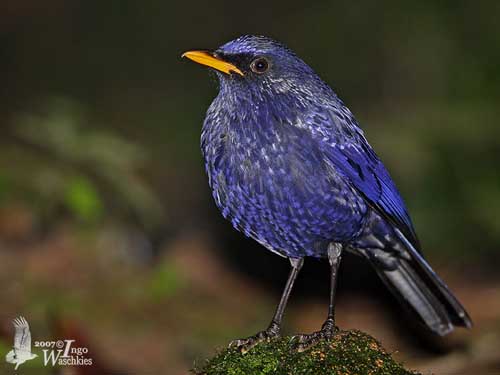
Fr: Arrenga siffleur
All : Purpurpfeifdrossel
Esp: Arrenga Común
Ital: Tordo zufolatore blu
Nd: Chinese Fluitlijster
Sd: Blå visseltrast
Photographers:
Niraj V. Mistry
Photo Galleries
Ingo Waschkies
My bird pictures on Pbase
Texte de Nicole Bouglouan
Sources:
HANDBOOK OF THE BIRDS OF THE WORLD Vol 10 by Josep del Hoyo-Andrew Elliott-David Christie - Lynx Edicions - ISBN: 8487334725
THRUSHES by Peter Clement and Ren Hathway – HELM - ISBN: 0713639407
L’ENCYCLOPEDIE MONDIALE DES OISEAUX - Dr Christopher M. Perrins - BORDAS - ISBN: 2040185607
BirdLife International (BirdLife International)
XENO-CANTO – Sharing Birds sounds from around the world
Blue Whistling-Thrish
Myophonus caeruleus
Passeriforme Order – Muscicapidae Family
BIOMETRICS :
L : 29-35 cm
Poids : 135-230 gr
DESCRIPTION:
The Blue Whistling-Thrush shows a beautiful glossy violet-blue plumage, making this bird a jewel in the green vegetation along the water. Even duller than on this page, that is really a nice bird.
The race M.c. crassirostris is here displayed. This subspecies is slightly smaller. The yellow bill is thicker and slightly shorter. On the underwing, the primaries often have white bases.

The adult male is bluish-black, but the colour may change according to the lighting.
The upperparts show violet-blue spots, heavily concentrated from the forehead to the crown sides. Lores are black.
The underparts are dull blue on lower breast and belly.
Wings and tail are deeper blue with some fine silver spots on the median upperwing-coverts. The lesser wing-coverts form a blue shoulder patch which is often concealed.
The nominate race has black bill, legs and feet, and reddish to dark brown eyes.
The female is similar to the male but her plumage is duller.
The juvenile has sooty-black plumage. The breast shows thin whitish shaft streaks.
We can find six subspecies which are very similar, but except the nominate race M.c. caeruleus, the other races have bright yellow bill with blackish culmen.
VOICE: SOUNDS BY XENO-CANTO
The Blue Whistling-Thrush’s call is a sharp whistle or a strident far-carrying “tzeet-tze-tze-tzeet” often given at dawn and dusk in long series.
The alarm call is a loud, shrill “kreee” or a longer “scree-chit-chit-chit”.
The song is given from perch, tree or cliff, and all year round. It includes melodious phrases composed of clear, short and high-pitched human-like whistles, sometimes with mimicry.
HABITAT:
The Blue Whistling-Thrush frequents gorges and ravines with deciduous forests and open bush with some larger trees. This species breeds between 1000 and 4000 metres of elevation, and winters from lowlands and mangroves up to 2400 metres.
It is often seen on the ground near rocky streams and even larger rivers.
According to the range, it frequents mangroves and scrubs, tall forest, parks and gardens, small wooded islets, and occurs sometimes very far from water in open rocky grounds and cultivated fields.
RANGE:
The Blue Whistling-Thrush occurs in C and SE Asia, India, C and E China, Java and Sumatra.
This species is common but patchily distributed.
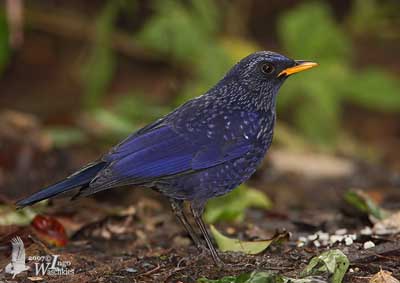
BEHAVIOUR:
The Blue Whistling-Thrush feeds primarily on invertebrates such as various insects, but also slugs, snails, earthworms and small crustaceans. It also consumes berries and seeds. The snails are broken against a hard surface in typical Turdus-thrush fashion.
It feeds on the damp ground by hopping, turning over the dead leaves and pecking in shallow water and along the muddy shores.
It also digs strongly in soft parts of the ground. It forages in riverbeds and takes floating food items. It is often active at dusk, until well after dark. During the day, it often rests on low branch in the dense vegetation.
It is usually seen alone in winter, or in pairs, and both mates often remain together throughout the year.
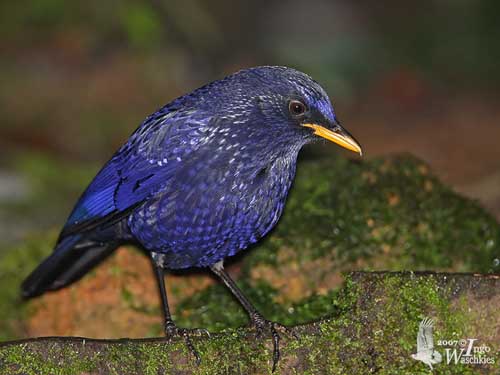
The Blue Whistling-Thrush may be aggressive against intruders such as raptors and owls entering its breeding territory. The threat displays involve aggressive postures with the breast puffed out.
When landing, the bird raises its tail over its back, and then, it lowers and fans it slowly.
This species can use the same breeding territory and nest year after year.
The Blue Whistling-Thrush is mainly resident, but it performs altitudinal movements.
FLIGHT:
The Blue Whistling-Thrush has fast and powerful flight.
REPRODUCTION:
The breeding season varies according to the range. The species usually produces two broods per season, but often only one at highest elevation.
The nest is a bulky cup placed on cliff ledge, in overhanging bank, or even in cave or crevice by running water, but also in tree cavity or under bridge, sometimes in tree fork. Both adults build the nest.
The cup is made with moss and muddy rootlets woven with fine grass, leaf stems and tendrils. The interior is lined with softer materials, mud and horsehair. The nest is usually reused year after year, but not always by the same pair.
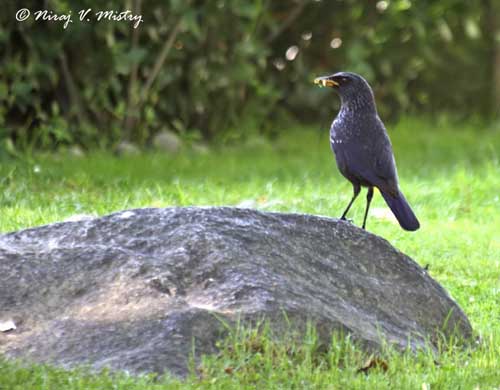
Race M.c. temminckii
Northern India
The female lays 3-4 pale eggs with darker markings. The incubation and all the nesting duties are shared by both parents and they also feed the young birds together.
The Blue Whistling-Thrush’s nest is sometimes parasitized by Large Hawk-cuckoo (Cuculus sparverioides).
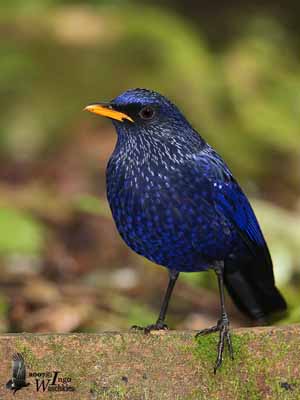
DIET:
The Blue Whistling-Thrush feeds primarily on invertebrates such as water beetles, ants and various hymenopterans, insects and their larvae, grasshoppers, but also slugs, snails, earthworms and small crustaceans.
PROTECTION/THREATS/STATUS:
The Blue Whistling-Thrush is relatively common in most parts of the range where it can find water such as rivers and rocky streams.
The species is not currently threatened.
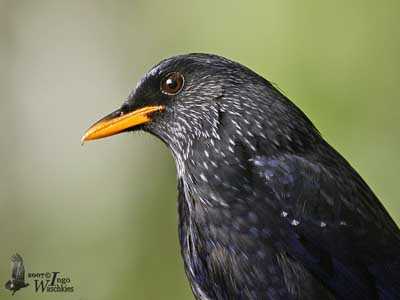
Natural coloration.
Picture taken without the use of the flash.